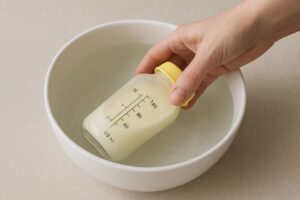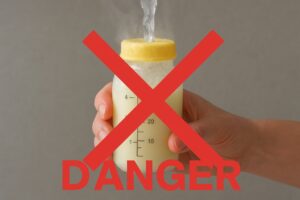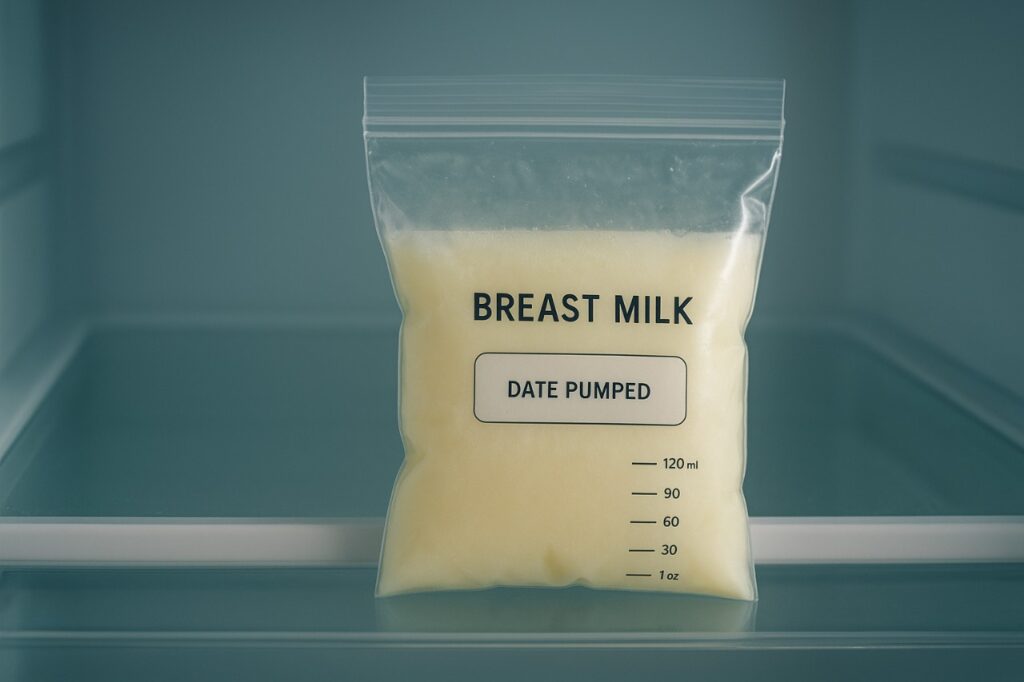Why Safe Thawing Matters for Every Mom
Freezing breast milk is a lifesaver for busy moms, but thawing it correctly is just as important. If you thaw milk too quickly or at the wrong temperature, you risk destroying vital nutrients or encouraging bacterial growth.
In the U.S., many parents store milk for weeks or months — but when it’s time to use it, they often wonder: “Can I just leave it on the counter?” or “Is warm water okay?”
This guide walks you through safe thawing techniques backed by CDC and Mayo Clinic standards — so every bottle you feed your baby stays as pure, fresh, and nutrient-rich as when you pumped it.
👉 Before continuing, check our detailed guide on How Long Can Breast Milk Stay at Room Temperature? (CDC Storage Guide) to understand how time and temperature affect safety.
Step 1: Move Frozen Milk from Freezer to Refrigerator
The safest way to thaw breast milk is gradually, by moving it from the freezer to the fridge.
- Transfer time: 12 to 24 hours, depending on milk volume.
- Once fully thawed, keep it in the refrigerator for up to 24 hours (not more).
- Never refreeze milk once it has thawed.
This slow thawing method preserves immune compounds like lactoferrin and immunoglobulins, keeping the milk’s natural antibacterial power intact.
Step 2: Use Warm Water for Gentle Thawing (If in a Hurry)

If you need milk faster, use a bowl of warm water (no hotter than 99°F / 37°C).
- Place the sealed milk bag or bottle in a bowl of warm tap water for 15–20 minutes.
- Gently swirl (don’t shake) the milk to even out temperature.
- Use immediately after thawing.
Avoid:
- Direct boiling water — it destroys live enzymes.
- Microwave — it causes uneven heating and burns nutrients.
👉 For detailed warming temperature guidelines, read Can You Put Breast Milk Back in Refrigerator? (Safety & Reuse Tips).
Step 3: Never Thaw Milk at Room Temperature Overnight
Many moms assume that leaving frozen milk on the counter will speed things up. Unfortunately, that’s unsafe.
Room temperature (especially above 77°F / 25°C) allows bacteria to multiply within hours.
Even if the milk looks normal, the nutrients and antibodies begin to break down once it warms past body temperature. Always choose either refrigerator or warm water methods — never countertop thawing.
Step 4: Label and Use Thawed Milk Wisely
Once milk is thawed, label it as “THAWED” and note the time and date.
✅ Use within 24 hours after it’s completely thawed in the refrigerator.
❌ Do not refreeze it again, even if unused.
If your baby doesn’t finish a bottle, discard any remaining milk within 2 hours of feeding.
Step 5: Understand the Texture and Smell of Thawed Milk
Thawed milk often separates — with fat rising to the top. That’s normal.
Swirl gently to mix. If the milk smells sour or rancid, discard it immediately.
However, a slightly soapy or metallic smell doesn’t always mean it’s bad — it’s likely caused by lipase, a natural enzyme that breaks down milk fats.
To reduce strong lipase smell, some moms scald fresh milk (heat to 180°F, then cool rapidly) before freezing — but this is optional.
The Science Behind Thawing: Protecting Nutrients and Antibodies
Freezing preserves milk, but thawing activates bacterial growth again.
Studies show that slow thawing (in the fridge) helps maintain:
- Lactoferrin (for immunity)
- Lysozyme (for antibacterial action)
- Vitamin C and IgA antibodies
Rapid warming, on the other hand, breaks down these delicate compounds.
So, even when you’re in a rush, take the gentle route — it keeps your milk biologically active and baby-safe.
👉 Read more about the science of breast milk handling from the La Leche League International.
Common Mistakes to Avoid While Thawing Frozen Milk

- ❌ Using boiling water or microwave — destroys nutrients.
- ❌ Re-freezing thawed milk — increases bacterial contamination.
- ❌ Leaving milk at room temperature for hours — spoils quickly.
- ❌ Shaking too hard — damages fat structure and antibodies.
- ✅ Best practice: Thaw in fridge overnight and warm gently before feeding.
FAQ: Thawing Frozen Breast Milk
Q1: Can I thaw milk in hot water?
No. Use only warm (not hot) water — around body temperature (99°F / 37°C).
Q2: How do I thaw milk while traveling?
Use an insulated cooler with frozen ice packs. Once semi-thawed, refrigerate immediately.
Q3: Why does thawed milk smell different?
It may be due to lipase activity, not spoilage. If the milk smells sour or rancid, discard it.
Q4: Can I mix thawed milk with fresh milk?
Only if both are at the same temperature — read our post Can You Mix Refrigerated and Fresh Breast Milk? for safety details.
Q5: What’s the maximum time I can keep thawed milk?
24 hours in the fridge — never refreeze.
Minor Enhancement Recommendation
Even though this guide is thorough, you can strengthen it by adding a short paragraph on “Body Temperature Thawing.”
Mention that breast milk ideally should not be warmed beyond 37°C (98.6°F) — which matches your baby’s body temperature — as higher heat damages immune proteins and vitamin integrity.
Conclusion: Thaw Gently, Feed Safely
Thawing frozen breast milk isn’t complicated, but it demands care.
By using slow, controlled methods — refrigerator or warm water — you preserve everything that makes breast milk the healthiest food for your baby.
Every ounce counts, and every degree matters.
Follow this routine and give your baby the safest, most nutrient-rich milk possible — every single time.

